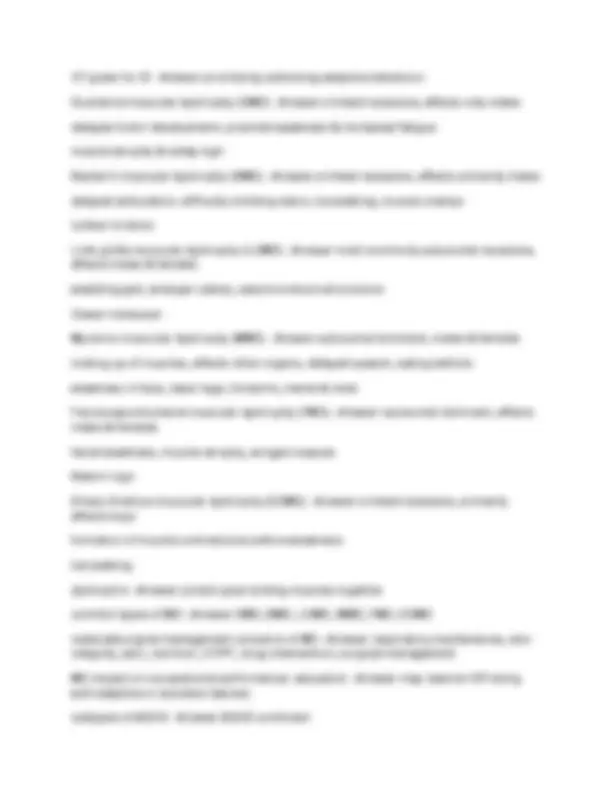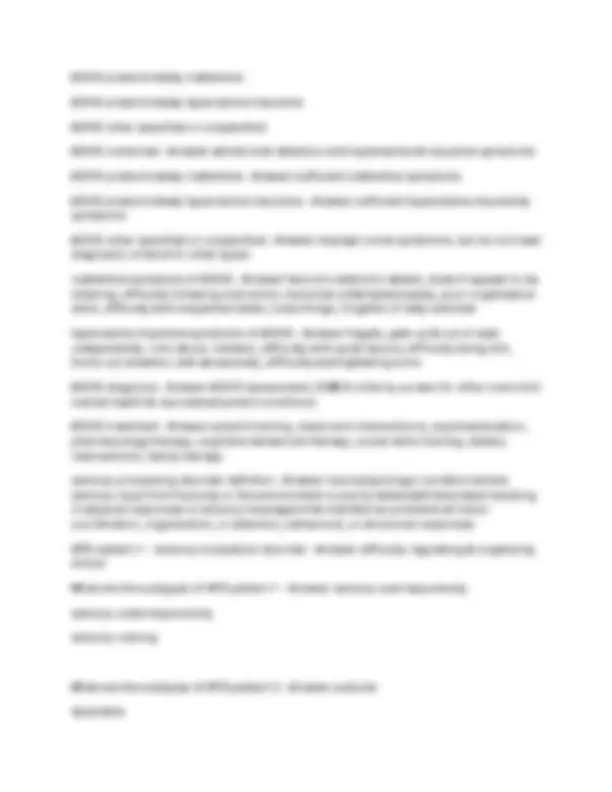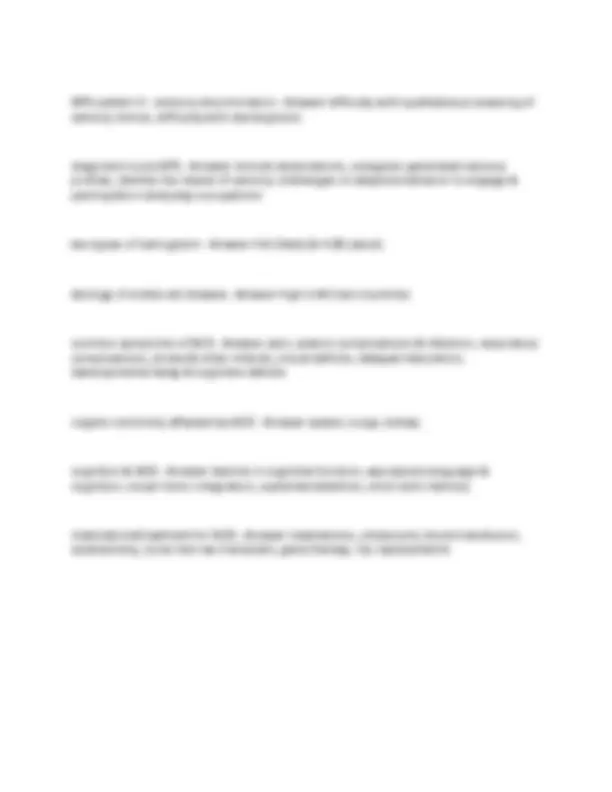





Study with the several resources on Docsity

Earn points by helping other students or get them with a premium plan


Prepare for your exams
Study with the several resources on Docsity

Earn points to download
Earn points by helping other students or get them with a premium plan
Community
Ask the community for help and clear up your study doubts
Discover the best universities in your country according to Docsity users
Free resources
Download our free guides on studying techniques, anxiety management strategies, and thesis advice from Docsity tutors
OT 5012 Exam 1 Questions And Correct Answers
Typology: Exams
1 / 5

This page cannot be seen from the preview
Don't miss anything!




7 foundational core values - Answer Justice Equality Truth Prudence Dignity Freedom 5 additional core values - Answer Imagination Courage Resilience Integrity Mindfulness personalized medicine - Answer process to determine best health care options for a particular patient person first language - Answer person be identified first then disease second What are the 3 types of pyramidal CP? - Answer spastic hemiplegia, spastic diplegia, spastic quadriplegia What are the 3 extrapyramidal types of CP? - Answer dyskinetic, ataxic, mixed spastic hemiplegia CP - Answer dragging one side spastic diplegia CP - Answer both lower extremities spastic quadriplegia CP - Answer 4 limb involvement dyskinetic CP - Answer athetosis (abnormal muscle contractions), head and trunk control ataxic CP - Answer staggering & unsteady gait, tremors mixed CP - Answer two types together due to brain damage risk factors of CP - Answer prematurity, low birth weight, infections
associated disorders of CP - Answer cognitive impairment, orthopedic conditions, seizure disorder, visual impairments, oral motor & communication disorders, gastrointestinal & pumonary Interventions for managing abnormal tone & spasticity CP - Answer joint fusions, tendon lengthening, selective dorsal rhizotomy, spasticity meds, orthotics CP impact on occupation: play & leisure - Answer have difficulty and lower playfulness scores DSM-V definition of autism - Answer impairments in social interaction & social communication that occur over several contexts & by the presence of restricted & repetitive behaviors level 3 severity level of ASD - Answer requiring very substantial support level 2 severity level of ASD - Answer requiring substantial support level 1 severity level of ASD - Answer requiring support eye tracking & ASD - Answer has shown to have positive effects on kids with ASD brain connectivity & ASD - Answer may have some brain connections that are strong, and some that are weaker core symptoms of autism - Answer difficulty in social interaction and restricted & repetitive behaviors process & timeframe for diagnosis ASD - Answer screening, developmental pediatrician, psychologist, SPT & OT, evaluation complementary & alternative medicine ASD - Answer supplements, mind-body treatments, biologically based treatment intellectual disability definition - Answer characterized by significant limitations in both intellectual functioning and adaptive behaviors DSM V classifications of ID - Answer mild, moderate, severe, profound AAIDD classifications of ID - Answer intermittent, limited, extensive, pervasive common single gene disorders that can cause ID - Answer tuberous sclerosis, PKV & taysachs, fragile X prenatal causes for ID - Answer maternal exposure to chemical agents, maternal diseases, maternal health perinatal causes for ID - Answer mechanical injuries, hypoxic events, active infections Down syndrome & ID/ course & prognosis - Answer lifelong condition, not progressive, managing medical conditions, impact of stigma
ADHD predominately inattentive ADHD predominately hyperactive impulsive ADHD other specified or unspecified ADHD combined - Answer exhibit both attention and hyperactive & impulsive symptoms ADHD predominately inattentive - Answer sufficient inattentive symptoms ADHD predominately hyperactive impulsive - Answer sufficient hyperactive impulsivity symptoms ADHD other specified or unspecified - Answer displays some symptoms, but do not meet diagnostic criteria for other types inattentive symptoms of ADHD - Answer failure to attend to details, doesn't appear to be listening, difficulty following instruction, becomes sidetracked easily, poor organization skills, difficulty with sequential tasks, loses things, forgetful of daily activites hyperactive impulsive symptoms of ADHD - Answer fidgets, gets up & out of seat unexpectedly, runs about, restless, difficulty with quiet leisure, difficulty being still, blurts out answers, talk excessively, difficulty waiting/taking turns ADHD diagnosis - Answer ADHD assessment, DSM-V criteria, screen for other comorbid mental health & neurodevelopment conditions ADHD treatment - Answer parent training, classroom interventions, psychoeducation, pharmacology therapy, cognitive behavioral therapy, social skills training, dietary interventions, family therapy sensory processing disorder defintion - Answer neurophysiologic condition where sensory input from the body or the environment is poorly detected/interpreted resulting in atypical responses to sensory messages that manifest as problems w/ motor coordination, organization, or attention, behavioral, or emotional responses SPD pattern 1 - sensory modulation disorder - Answer difficulty regulating & organizing stimuli What are the subtypes of SPD pattern 1 - Answer sensory overresponsivity sensory underresponsivity sensory craving
What are the subtypes of SPD pattern 2 - Answer postural dyspraxia
SPD pattern 3 - sensory discrimination - Answer difficulty with qualitative processing of sensory stimuli, difficulty with stereognosis
diagnostic tools SPD - Answer clinical observations, caregiver-generated sensory profiles, identify the impact of sensory challenges on adaptive behavior to engage & participate in everyday occupations
two types of hemoglobin - Answer Hbf (fetal) & HGB (adult)
etiology of sickle cell disease - Answer high in African countries
common symptoms of SCD - Answer pain, splenic complications & infection, respiratory complications, stroke & other infarcts, visual deficits, delayed maturation, developmental delay & cognitive deficits
organs commonly affected by SCD - Answer spleen, lungs, kidney
cognition & SCD - Answer decline in cognitive function, expressive language & cognition, visual motor integration, sustained attention, short term memory
medications/treatment for SCD - Answer medications, ultrasound, blood transfusion, splenectomy, bone marrow transplant, gene therapy, hip replacements